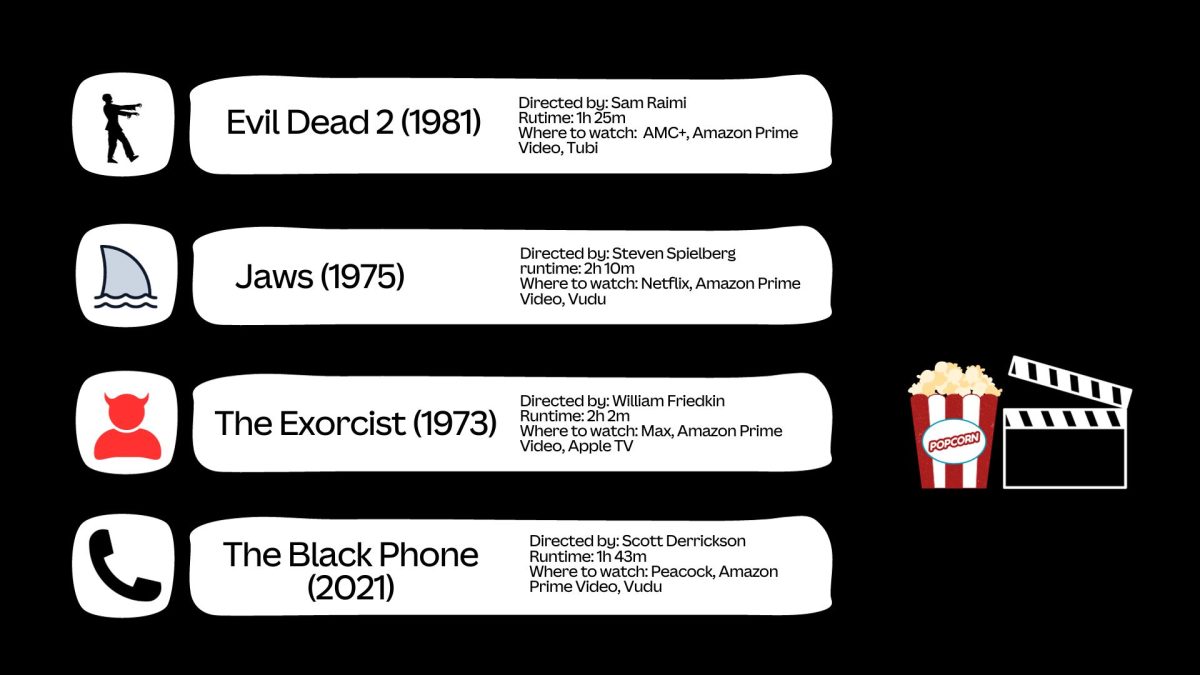Halloween is just around the corner, which makes it the perfect time to watch some good horror movies.
From slashers and monsters, supernatural or psychological, horror movies are constantly being released. This year included some returning sequels and original ideas such as “Saw X,” a movie following a serial killer getting cancer treatment, and “Talk to Me,” a movie about a demonic and euphoric relic.
According to Rotten Tomatoes, there have been 86 horror movies released for theaters and streaming services this year.
The horror genre has also taken over other holidays, such as Thanksgiving and Christmas. Two holiday-horror-themed movies releasing later this year are “Thanksgiving,” featuring a murderous pilgrim, and “It’s a Wonderful Knife,” a trippy Christmas horror movie about traveling through a parallel universe.
Inspiration for a horror movie can originate from a variety of sources, such as learning more about folklore or expanding on what was frightening as a child to come up with a concept.
Pablo Riquelme Cuartero, a San Francisco State University cinema lecturer, created a horror movie in Spain about stories he heard as a kid, with his family functioning as both cast and crew.
At 17, he was able to enter his movie in the Sitges Horror Film Festival, a prestigious film festival in Spain.
“I started making my own short films,” Cuartero said. “I think by being on set I was like, ‘you know, this crap is not that complicated. You just need lights, a camera, a few crazy friends and then you can make your own movie.’”
His love for movies began when he became a child actor at the age of 11, starring in multiple plays before getting his break in a movie series titled “La Noche de Monje.”
Cuartero’s early success piqued the interest of horror movie directors who wanted to collaborate with him. Jaume Collet-Serra, director of “House of Wax” and “The Orphan,” was one of Cuartero’s earliest mentors.
Cuartero’s most recent movie, “Heads Will Roll,” stars iconic horror actor Tony Todd, who has appeared in movies such as “Final Destination,” and most famously in the “Candyman” series.
“I consider Tony also a mentor because the things that I learned from him from a director-actor perspective, there’s no book that teaches certain things,” Cuartero said. “I feel good that I bumped into these people and that we somehow were able to create a mentor-protege relationship.”
As vital as directing is in filmmaking, a filmmaker must also rely on a cinematographer, whose role is to capture the best visuals possible.
Oliver Calderon, a third-year student at SFSU and the public relations officer for SFSU’s cinema collective club, has previously worked on filming music videos for his friends in San Diego.
Calderon’s love for cinematography came at an early age when he picked up his first camera. Since then, Calderon has been curious about what he could achieve with movies.
“I never really pay attention to the actual plot or narrative but more of, ‘how did they get this shot or how did this guy get this shot in the middle of nowhere,’” Calderon said. “Those behind- -the-scenes attributes really intrigued me into getting into the role of cinema.”
Calderon has also expressed interest in editing, claiming that they could do it for hours if they have to.
As a kid, Calderon was frightened of horror movies and avoided them as much as possible.
“My whole childhood I was just a scaredy-cat, I could not handle them,” Calderon said. “They’re just sometimes too frightening and I was just afraid of getting nightmares.”
His first horror movie experience came when his cousin showed him a movie of two horror icons clashing together, “Freddy vs. Jason.”
“The cinematography was all over the place,” Calderon said. “As a movie enthusiast now I’m just like, ‘Okay, that’s not the best horror movie,’ but that was my first ever horror movie that I got exposed to and I loved it as a kid.”
Cinematography is an important element when it comes to filmmaking. However, filming a movie cannot begin unless a proper script has been written.
Writing a script can be difficult, especially when it comes to rewrites. However, Julian Hoxter, the SFSU School of Cinema screenwriter advisor, says it is vital due to the ever-changing sequences of a script.
“The real writing starts when you finish the first draft,” Hoxter said. “ When you get to the end, things have changed — because you’ve discovered things, changed things and developed things in the draft, meaning that some of the stuff you wrote earlier may not totally fit with what you’ve written later.”
Hoxter earned his master’s degree in film studies in the U.K. at the University of East Anglia and then proceeded to film school at University of California, Los Angeles. Hoxter’s career began with writing for documentaries and independent feature films, despite his original goal of wanting to be an actor.
As a screenwriter, Hoxter understands that a script needs to go through numerous iterations before it is finished. According to Hoxter, writing extra to develop a specific character or fill out some conversation drastically impacts the remainder of the plot.
Hoxter believes that typically it takes a couple of months to effectively compose and build a decent script. He indicated that students may struggle to balance screenplay writing, school and work.
“I don’t expect a writer who doesn’t have that much experience to manage to do a full draft every semester,” Hoxter said. “Some do, but for people who haven’t really taken that on board before — I think you can push people to produce but I don’t think it’s healthy.”









